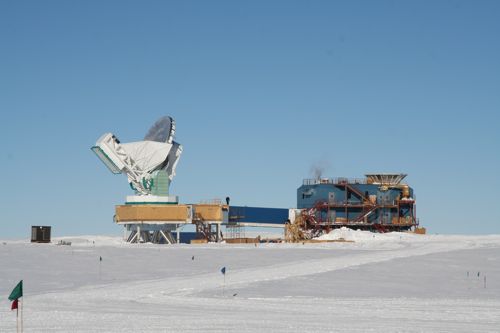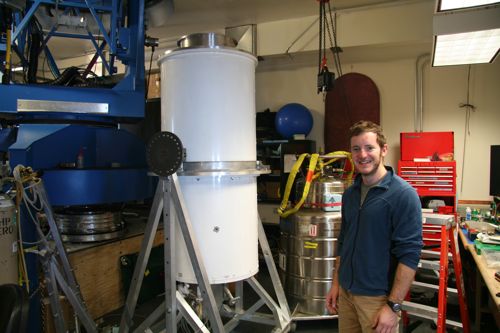Almost everything down here is known via acronyms - abbreviations that sometimes spell out something clever, or sometimes just random codes. This especially goes for research projects, with the exception of IceCube - which just means a cube of ice.
I already wrote a journal about the ARO, but today's topic is a pair of similar research projects, SPT and BICEP, that study the cosmic microwave background radiation.

For the non-physicists out there, a quick rundown on this "cosmic microwave background radiation"... Way back about 13.7 billion years ago, the Big Bang happened (or so goes the consensus of astrophysicists who know of these things). Lots of stuff happened really quickly, such as the universe being formed. The universe was a ball of super-hot particles that expanded quickly, including for a time, faster than the speed of light! Wrap your mind around that one!
You may be aware that as we look out into space, we see the stars and such not the way they currently are, but what they looked like when that particular bit of light was formed; and since they are very far away, it takes a long time for that light to travel to us. For example, the closest star to us is about 4 light-years away, meaning light from that star takes 4 years to reach us. A light year is a distance, not a time - the distance a photon of light will travel in one year.
The farther we look in the universe, the older stuff gets - until we look so far away, and so far back in time (about 13.7 billion years), the universe looks like a solid wall of microwave radiation, which equates to a "temperature" of about 2.7 Kelvin, just above Absolute Zero. If we try to look farther back, we can't, because the matter of the universe before that time was too energetic, and photons could not get out. This is the same reason we can't see through the sun's surface, it's just too hot underneath!
It turns out, the universe had to cool down enough for atoms to form before the light could escape. The temperature at this point, about 300,000 years after the big bang, cooled to about 6000 degrees K (about the same temperature as the sun's surface), atoms started to form, and light could begin to escape. This light was basically the color orange.
(Side note: isn't that awesome? the color of the early universe was orange!)
OK. As the universe continued to expand, these orange light waves were stretched along with it. If you take a photon of orange light, and increase its wavelength, it becomes red. If you stretch it more, it becomes infrared. If you keep stretching, eventually it becomes long wavelengths of electromagnetic radiation called "microwaves" - don't watch the food cook! And scientists discovered that everywhere they looked in the universe, past all the stars and galaxies, was this microwave "glow" left over from the big bang.
Now on to SPT and BICEP.
SPT stands for South Pole Telescope - not all that clever but very descriptive. Its reflector dish is 10 meters (about 30 feet) across - and it records this cosmic microwave background radiation (CMBR). As it scans the skies, it looks for tiny variations in the CMBR that might happen because there is a cluster of galaxies in the way. The main idea is to survey the sky to identify thousands of galactic clusters, which may help us understand dark energy.

BICEP stands for Background Imaging of Cosmic Extragalactic Polarization, which is a clever acronym but is hard to decipher what it means. The BICEP project is also looking at the CMBR, but for different reasons and in a different way. The idea is that, as the universe expanded, gravity waves caused the light to become "polarized" - so the light waves are lined up in the same basic direction. Polarized sunglasses work because they can block light that lines up in one way (like light reflected off the surface of a lake or a road - lined up side-to-side) but allows light that's lined up the other way (polarized in the up-down direction) to pass through so you can see. BICEP looks at how the background radiation is polarized, which tells them more information about the conditions and behavior of the universe at that point 300,000 years after the big bang.
Congratulations, this concludes your intensive course in astrophysics from the O'Hara College of Sciencey Studies.


Comments